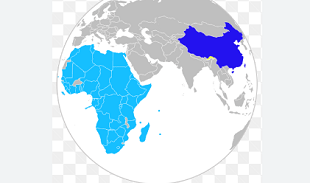By Jane Muthumbi – I have grown up thinking the most about poverty, which afflicts much of the developing world. Despite its decline globally in the last four decades, many developing countries are now grappling with growing poverty following recent crises.
Currently, over a third of the population in Sub-Saharan Africa (36 per cent in 2024), and about 7 per cent in North Africa is living in extreme poverty. Alarmingly, 468 million Africans are living in extreme poverty, up from 285 million in 1990.
But then I have often wondered if any country has been able to tackle this challenge. Indeed, China – a developing country – has managed to reduce its poor population by 800 million between 1980 and the early 2000s, and by 2020, extreme poverty had effectively been eradicated. Hence, China achieved Sustainable Development Goal (SDG) 1 on No Poverty ten years ahead of the target set by the SDGs.
How did China manage this unthinkable feat? As a participant in a recent seminar on China’s Experience in Sustainable Development and Poverty Reduction for Developing Countries held in Beijing, I learnt about China’s experience with poverty eradication and how it could inform Africa’s efforts.
Africa, like China, has made progress in reducing poverty. In three decades, extreme poverty decreased substantially, with the robust economic growth in the 2000s contributing to the decline. However, much of the progress was reversed during COVID-19 pandemic. Besides, inequality is pervasive on the continent, particularly in southern Africa.
Unlike Africa, in China currently, there are no visible signs of poverty, not just in Beijing, but also on the outskirts. On the bullet train to field visits in southeastern China, high-rise apartments are a common sight.
So, how did China manage to transform from a low-income country in 1978 to the world’s second largest economy by 2010 and eradicate poverty?
China’s structural transformation, fuelled by economic growth, provided the impetus for poverty reduction. Industrialization and modernized agriculture created employment and economic opportunities in urban and rural areas alike. With the transition to higher productivity sectors and activities, and the improvement in people’s skills, incomes increased and poverty decreased.
Farmers in Shannanton Village, Wuxi earn incomes from diverse cultural activities, agro-tourism and homestays
China’s rapid urbanization contributed to rural development. Industries in urban areas created demand for agricultural products, with the rural-urban linkages stimulating the sector’s growth. At the same time, agricultural innovation and the upgrade of infrastructure, increased agricultural output and contributed to rural revitalization.
China’s expansion of social safety nets for underserved rural households improved their welfare and helped lift the marginalized groups out of extreme poverty. Moreover, the Common Prosperity Agenda, which aims to address social inequality and economic inequity, reduced income inequality between rural and urban regions, and accelerated poverty reduction.
There are four lessons that Africa can learn from China’s success:
Structural transformation is integral to poverty reduction. Africa needs to structurally transform its economies in order to raise productivity and increase competitiveness. The transition to high productivity activities in agriculture, the green economy other emerging sectors can create economic opportunities that enable people to earn incomes that are high enough to escape the poverty trap.
Investing in human capital development is crucial. Africa needs to invest in its people. Its growing youthful population – the largest globally, requires appropriate knowledge and skills to enable them to take advantage of emerging economic opportunities. Enhancing the skills and improving the productivity of Africa’s working poor in the informal sector is also crucial for poverty reduction.
Reducing inequalities of opportunity is imperative. Africa must reduce the widespread inequality of opportunity that is reflected in the lack of access to essential services in urban slums and rural areas. Investments in infrastructure in these areas can help curb growing urban and rural poverty on the continent. Better harnessing of rural-urban linkages could be a win-win for regional development by reducing disparities while enabling regions to reap economic benefits.
Targeted support to underserved populations is essential to leave no one behind. Africa needs to better target the social safety nets for informal workers, women, youth and rural residents who are often not covered by social protection to reduce vulnerabilities and mitigate risks that push people into and keep them in poverty.
With China having initiated its poverty reduction efforts while having a large rural population and amid rapid urbanization, lifting millions of Africans out of poverty is within the realm of possibility.
Indeed, Mauritius, Tunisia, Algeria, and Seychelles, which are all on track to eradicate poverty by 2030, are making significant strides in reducing poverty through better targeting of vulnerable populations and by structurally transforming their economies.
With concerted efforts, Africa can lift all boats and build a more inclusive future that delivers for all.
EDITOR’S NOTE: The writer, Jane Muthumbi, is Economic Affairs Officer, Gender, Poverty and Social Policy Division at the UN Economic Commission for Africa.

